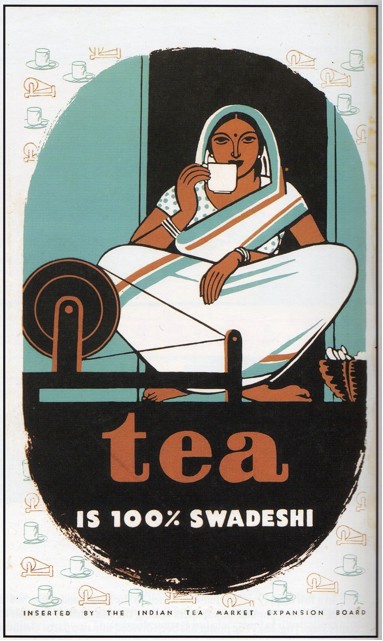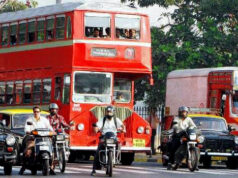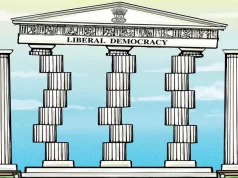To a wise man, the whole earth is open; for the native land of a good soul is the whole earth.
~ Democritus of Abdera Circa 420 BC
It was not long ago that the British set up and began commercial production of tea in India in 1840 through the Assam Tea Company. But if it was only in the mid-1800s that they set up tea production, then what were we drinking before? Not many know that ‘tea’ was an alien concept for Indians, we were happy with our kada or just water. According to an article “…British in India used to consume Chinese tea in massive quantities but eventually they started tea cultivation and production in India”. For the longest time tea used to be a drink for the rich but mass and local production made it possible for lesser able Indians as well to enjoy this caffeinated drink. In her book, “Curry”, historian Lizzie Collingham says that the taste for tea was cultivated in India through a dedicated push on part of the producers of tea (the British) and initially, free samples of tea were offered to houses. And now, ek kadak garam chai ki cup is what starts the day in many households in India, we no longer subsist on kada. According to The Hindu, the all-India per capita tea consumption is 0.8 kg and the value of the domestic tea market is estimated at ₹15,000–20,000 crore.
Joseph Schumpeter (1883–1950) would describe this phenomenon as “creative destruction” which refers to the incessant production and process innovation mechanism by which new production units replace outdated ones. He also considered this an “the essential fact about capitalism’’.
In India, we have seen a lot of “creative destruction”. Trade and commerce has helped in this process to facilitate our technological advance and establish us in the global market. The two — trade and globalisation — are also interrelated. Trade leads to creative destruction, globalisation accelerates the process of trade and also opens the market, so as globalisation occurs and we get access to new technology, our process of creative destruction also accelerates.
The problem however, is that every time people talk of globalisation and creative destruction, it is a negative perception that arises in people’s minds. We focus more on the aspect of “destruction”, and not on the benefits that are accrued out of it. Let’s try and explore the effects of creative destruction through three simple and daily used products.
1. Cable TV
Summer vacations as a child meant binge watching popular TV shows like Shaktiman, Motu Patlu, Captain Vyom and a few others on Doordarshan, but then came a phase when Doordarshan 2 (DD Metro) came into our lives. Suddenly, we had choices and options. And soon after, we saw a revolution in the broadcasting industry. People now spent their lazy days watching channels like Zee TV and Star TV. But change is never so easy, it comes with challenges — more options basically meant more competition and in return lower TRP for Doordarshan. This certainly put the management in an uncomfortable position. They therefore filed a case against the Star TV network based in Hong Kong. According to “Sphere of Influence: Writings on Cricket and its Discontents” by Gideon Haigh, Doordarshan’s then-Director General, Rathikant Basu, barged into Calcutta’s Supreme Court brandishing the 109-year-old Telegraph Act in order to make his case against Star TV. Basu with the backing of the information and broadcasting minister, K P Singh Deo, argued that the “uplink of a video signal to a foreign organisation jeopardised national security”. The Supreme Court however eventually ruled the case out by saying airwaves were public property, and could be owned or rented by private parties under the watchful eyes of a regulatory authority.
With the globalised economy and creative destruction, now we have more than 1,000 TV channels with a few more online channels including YouTube and Netflix. Surely, the employees lost their jobs at their cable network, but did this not generate new avenues of employment? And did we as consumers not receive better channels and a lot entertainment?
2. Ice Cubes
Frozen water was an alien concept to us Indians. Ice cubes or basic ice was missing from our lives. I always wonder how we cooled water during summers in India because just earthen pots were not sufficient to quench the thirst caused by scorching heat.
Those who came in to settle here however, didn’t even have the respite that clay pots offer. They were not used to the heat. According to Ain-I-Akbari, in order to beat the heat the emperor Akbar used special boats to constantly bring ice from Srinagar in Garwha. Ice was loaded in ’12 seer’ bundles firstly wrapped in very clean cotton muslin, over which jute cloth was covered twice over, and then it was placed in a wooden box with wood shavings to fill in the gaps. This ice was then transported via elephant and horseback from Srinagar to Delhi — a journey that took two days to cover. This was a very costly affair and only the rich could afford ice and also to build ice-houses to store ice.
In fact, in the mid-19th century, there was a bustling ice trade. According to an article in Huffpost, ice was being traded in huge quantities in Europe at this time. Businessmen used to take labourers to cold places/frozen lakes or pond and start cutting the frozen water into smaller blocks. These pieces would then be loaded on a train and in some cases then transferred to ships. In fact the first ice during British era came as traded goods to Kolkata (Calcutta), from Boston.
Vivekanandar Illam was built in 1842 to be used as an ice house by an American entrepreneur called Frederic Tudor, who came to be called the “Ice King” because of his idea of transferring ice blocks from cold countries to hotter parts of the world. In India, the British were quite impressed by him since they were otherwise struggling in the heat of Calcutta and Bombay. Further research and development helped develop ice machines in India which further went on to become freezers and fridges.
People did lose their jobs during the process, the runners during Mughal era or the ship drivers or the labourers during British era but this led to a lot of technological advancement. As a result, we now have ice cubes readily available in the summers. Once a luxury, ice is now available, for as cheap as Rs 15 per kg. And the labour, effort and resources that went into this long-drawn-out activity have been redirected to much more fruitful pursuits.
3. Fans
India has always been a hot country. Our summers used to scare the British so much so, that they often said “the deadly heat of Calcutta was more dangerous to British life than any uprising by the natives.” The British started building their houses with compounds of shady trees and high ceilings while other rich officials followed the Mughal practice of building tehkhanas in their residences.
But be it British or Mughals, they always used hand fans or punkha. According to Sahibs’ India: Vignettes from the Raj by Pran Nevile “…It is a French seaman — Captain de Grandpre’ — who first describes the Calcutta punkha in 1790. In many houses, there was a large fan, hanging from the ceiling over the eating table, of a square form and balanced on an axle fitted to the upper part of it. A servant standing at one end of it, puts it in motion by means of a cord which is fastened to it in the same manner as he would ring a bell”.
Later on these big fans underwent modification to give better air to the Sahibs. The size of the fan also depended on how big the room was. In fact, fans became a reason to advertise public libraries and social events to attract masses.
Today, the kinds of fans and air conditioners that we have now have been nowhere even in the dictionary of Indians when they first discovered the benefits of punkhas.
Let’s question ourselves again; has globalisation changed our day to day life for good or bad? Schumpeter described this as a ‘process of industrial mutation that incessantly revolutionises the economic structure from within, incessantly destroying the old one, incessantly creating a new one.’ If the economy and technology is not evolving, it will stagnate and eventually die down. Morgan Stanley recently forecasted that Global GDP appears on pace to grow in 2018, an estimated 3.8% which is its strongest showing since 2011.
According to Jagdish Bhagwati, globalization has helped poor and developing countries to grow well. Globalisation has given people more disposable income, and life expectancy has almost doubled in the developing countries. Countries like India have largely benefited from this globalised economy — and a large part of this benefit has come from the technology and goods and creative destruction.
Post globalisation, India grew by 7% (on an average) as compared to mere 4% post-independence and which did lead to a remarkable reduction in poverty. Globalisation helped us create more jobs with the entry numerous new and young entrepreneurs. Gurgaon became the first city in the entire country to host MNCs on its land. Technology improved and flying to India became simpler which helped in growing tourism and made India the 7th in the world in terms of its total contribution to the global GDP.
The rapid expansion of globalisation and capitalism proclaims that it is the creative destruction and openness which has brought the change in the generation, economically and socially. Let’s embrace the change and not close our doors to it.
Post Disclaimer
The opinions expressed in this essay are those of the authors. They do not purport to reflect the opinions or views of CCS.






